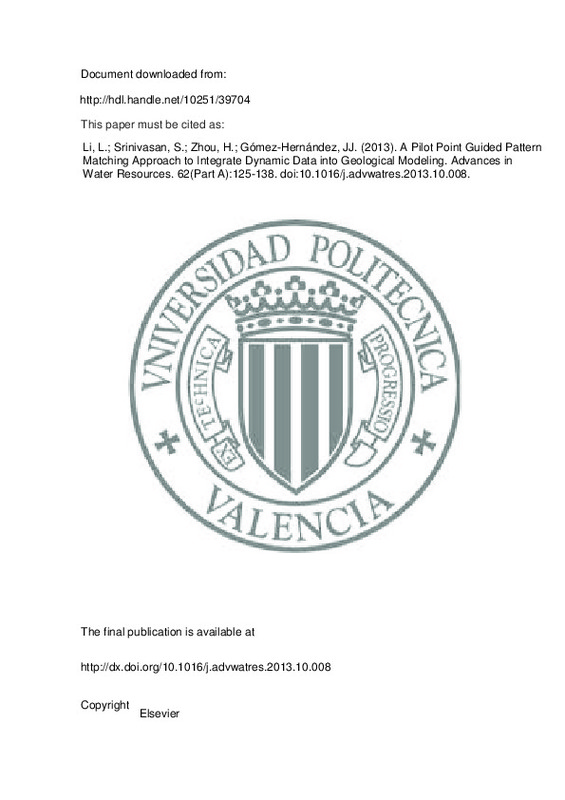JavaScript is disabled for your browser. Some features of this site may not work without it.
Buscar en RiuNet
Listar
Mi cuenta
Estadísticas
Ayuda RiuNet
Admin. UPV
A Pilot Point Guided Pattern Matching Approach to Integrate Dynamic Data into Geological Modeling
Mostrar el registro sencillo del ítem
Ficheros en el ítem
| dc.contributor.author | Li, Liangping
|
es_ES |
| dc.contributor.author | Srinivasan, Sanjay
|
es_ES |
| dc.contributor.author | Zhou, Haiyan
|
es_ES |
| dc.contributor.author | Gómez-Hernández, J. Jaime
|
es_ES |
| dc.date.accessioned | 2014-09-17T15:40:44Z | |
| dc.date.available | 2014-09-17T15:40:44Z | |
| dc.date.issued | 2013-12 | |
| dc.identifier.issn | 0309-1708 | |
| dc.identifier.uri | http://hdl.handle.net/10251/39704 | |
| dc.description.abstract | Methods based on multiple-point statistics (MPS) have been routinely used to characterize complex geological formations in the last decade. These methods use the available static data (for example, measured conductivities) for conditioning. Integrating dynamic data (for example, measured transient piezometric head data) into the same framework is challenging because of the complex non-linear relationship between the dynamic response and geology. The Ensemble PATtern (EnPAT) search method was recently developed as a promising technique to handle this problem. In this approach, a pattern is postulated to be composed of both parameter and state variables, and then, parameter values are sequentially (point-wise) simulated by directly sampling the matched pattern from an ensemble of training images of both geologic parameters and state variables. As a consequence, the updated ensemble of realizations of the geological parameters preserve curvilinear structures (i.e., non-multiGaussanity) as well as the complex relationship between static and dynamic data. Moreover, the uncertainty of flow and transport predictions can be assessed using the updated ensemble of geological models. In this work, we further modify the EnPAT method by introducing the pilot-point concept into the algorithm. More specifically, the parameter values at a set of randomly selected pilot point locations are simulated by the pattern searching procedure, and then a faster MPS method is used to complete the simulation by conditioning to the previously simulated pilot point values. This pilot point guided MPS implementation results in lower computational cost and more accurate inference of the parameter field. In addition, in some situations where there is sparsity of measured geologic static data, the EnPAT algorithm is extended to work only with the dynamic data. We employed a synthetic example to demonstrate the effectiveness of pilot points in the implementation of EnPAT, and also the capability of dynamic data to identify complex geologic structures when measured conductivity data are not available. | es_ES |
| dc.description.sponsorship | The first three authors gratefully acknowledge the financial support by DOE through project DE-FE0004962. The fourth author acknowledges the financial support by the Spanish Ministry of Science and Innovation through project CGL2011-23295. The authors also wish to thank Wolfgang Nowak as well as two anonymous reviewers for their comments, which helped improving the final version of the manuscript. | en_EN |
| dc.language | Inglés | es_ES |
| dc.publisher | Elsevier | es_ES |
| dc.relation.ispartof | Advances in Water Resources | es_ES |
| dc.rights | Reserva de todos los derechos | es_ES |
| dc.subject | Multiple-point geostatistics | es_ES |
| dc.subject | Conditional simulation | es_ES |
| dc.subject | Inverse modeling | es_ES |
| dc.subject | Ensemble-based methods | es_ES |
| dc.subject | History matching | es_ES |
| dc.subject.classification | INGENIERIA HIDRAULICA | es_ES |
| dc.title | A Pilot Point Guided Pattern Matching Approach to Integrate Dynamic Data into Geological Modeling | es_ES |
| dc.type | Artículo | es_ES |
| dc.identifier.doi | 10.1016/j.advwatres.2013.10.008 | |
| dc.relation.projectID | info:eu-repo/grantAgreement/DOE//DE-FE0004962/ | es_ES |
| dc.relation.projectID | info:eu-repo/grantAgreement/MICINN//CGL2011-23295/ES/MODELACION ESTOCASTICA INVERSA FUERA DE LO NORMAL/ | es_ES |
| dc.rights.accessRights | Abierto | es_ES |
| dc.contributor.affiliation | Universitat Politècnica de València. Departamento de Ingeniería Hidráulica y Medio Ambiente - Departament d'Enginyeria Hidràulica i Medi Ambient | es_ES |
| dc.contributor.affiliation | Universitat Politècnica de València. Instituto Universitario de Ingeniería del Agua y del Medio Ambiente - Institut Universitari d'Enginyeria de l'Aigua i Medi Ambient | es_ES |
| dc.description.bibliographicCitation | Li, L.; Srinivasan, S.; Zhou, H.; Gómez-Hernández, JJ. (2013). A Pilot Point Guided Pattern Matching Approach to Integrate Dynamic Data into Geological Modeling. Advances in Water Resources. 62(Part A):125-138. https://doi.org/10.1016/j.advwatres.2013.10.008 | es_ES |
| dc.description.accrualMethod | S | es_ES |
| dc.relation.publisherversion | http://dx.doi.org/10.1016/j.advwatres.2013.10.008 | es_ES |
| dc.description.upvformatpinicio | 125 | es_ES |
| dc.description.upvformatpfin | 138 | es_ES |
| dc.type.version | info:eu-repo/semantics/publishedVersion | es_ES |
| dc.description.volume | 62 | es_ES |
| dc.description.issue | Part A | es_ES |
| dc.relation.senia | 263357 | |
| dc.contributor.funder | Ministerio de Ciencia e Innovación | es_ES |
| dc.contributor.funder | U.S. Department of Energy | es_ES |







![[Cerrado]](/themes/UPV/images/candado.png)

